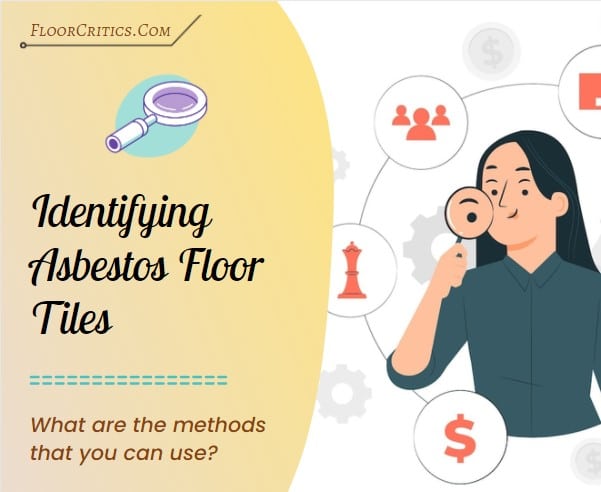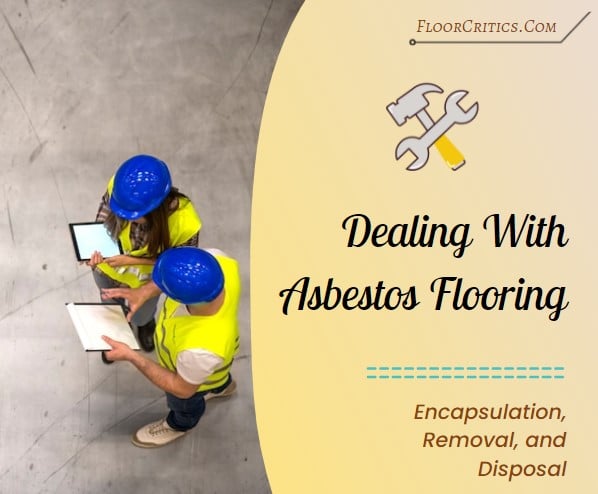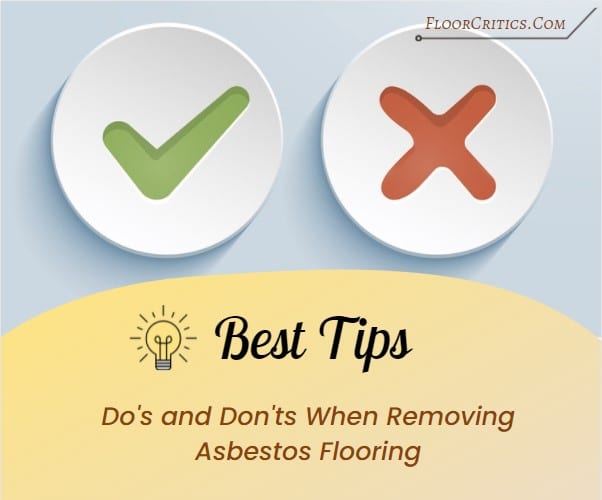
Asbestos flooring has been banned in the United States due to the serious health risks associated with it. However, it still exists in many homes constructed before the 1980s including asbestos-containing ceilings, drywall, and insulation.
So if you are worried about having asbestos in your home, this guide will show you how to tell if tile is asbestos and how to deal with it.
- What is Asbestos Tile?
- Is Asbestos Flooring Banned?
- Types of Asbestos Materials and Floor Tiles
- Health Issues of Asbestos Flooring: What Makes Them Dangerous?
- How to Identify Asbestos Floor Tiles
- Dealing With Asbestos in Tile Floor: Should You Be Worried?
- Covering Asbestos Floor Tiles
- Are Asbestos Floor Tiles Safe to Remove On Your Own?
- What Should You Do if You Accidentally Removed Asbestos Tiles?
- How to Remove Asbestos Tiles Safely
- Disposing Asbestos Tiles
- Do’s and Don’ts: Tips for DIY Removal of Asbestos Flooring
- Asbestos Floor Tile Removal Cost
- FAQs
- Final Thoughts
What is Asbestos Tile?
“Any floor tiles installed prior to 1980 should be presumed to contain asbestos — unless confirmed to be asbestos-free by a laboratory — and the proper protective actions should be taken.”
Occupational Safety and Health Administration (OSHA)
Asbestos tiles were widely used construction materials until the 1980s before their hazardous effects were discovered. There are three major varieties of asbestos tiles: floor, wall, and ceiling tiles. But, ceiling and floor tiles were more common.
Asbestos in tiles was popular because of its durability, heat-resistance, chemical resistance, fireproof properties, and good insulation features. Plus, they can also handle high traffic.
Is Asbestos Flooring Banned?
Although many regulations and laws have been passed to ban asbestos-containing materials including flooring materials, the US still hasn’t fully banned asbestos. However, many states have imposed strict rules regarding asbestos use.
Moreover, the Environmental Protection Agency (EPA) has also issued a final rule under the Toxic Substances Control Act (TSCA) in 2019. This rule ensures that discontinued asbestos products, including vinyl asbestos floor tiles, won’t be reintroduced into the market without EPA’s evaluation.
Types of Asbestos Materials and Floor Tiles
Asbestos in tile floors (both vinyl and asphalt) can be friable or non friable.
Asbestos Material Categorizations
There are two categorizations of asbestos materials:
| Friable Materials | Non Friable Materials |
| Materials that easily crumble or break with hand pressureThey are more likely to release toxic asbestos fibers into the airThey pose greater health risks than nonfriable materials | Cannot be crumbled or pulverized by hand and other forces during removal or demolitionCan effectively contain asbestos fibers as long as they are damage-free |
Asbestos Tile Floors Types
Asbestos flooring also comes in two major varieties based on the type of mineral used. They both can have up to 70% asbestos content by weight.
| Asphalt Floor Tiles (AFT) | Vinyl Asbestos Tiles (VAT) |
| Contain gilsonite and asphalt as their key binding agentsUsual sizes are 9″ x 9″ and 12″ x 12″ | Also known as plastic tilesOften preferred for high-traffic areasMain sizes are 9″ x 9″, 12″ x 12″, and 18″ x 18″ |
Things to Note:
- Undamaged asbestos floor tiles are considered non friable. However, they become friable once they crumble or are degraded, sanded, or scratched.
- You can safely walk on asbestos flooring that is in good condition (non friable). But, you should NOT use tools, sand, or scrape them.
- Other floor tiles (e.g. linoleum and laminate flooring) that are not made with asbestos may also have adhesives that contain asbestos. Asbestos backing on sheet vinyl floors is also common. Removing these types of flooring can expose the backing and release asbestos fibers.
Health Issues of Asbestos Flooring: What Makes Them Dangerous?
Asbestos floors that are in good condition are not seen as hazardous. But, damaged and friable asbestos flooring can release microscopic asbestos fibers into the air that are dangerous when inhaled.
The fibers can get trapped in your lungs and get stuck in your body for a long time. Since our bodies can’t dissolve asbestos, accumulated fibers can lead to scarring, inflammation, and genetic changes that can cause serious health problems.
According to the National Cancer Institute, below are the health hazards of exposure to asbestos:
- Mesothelioma (cancer in the linings of the abdomen or lungs)
- Asbestosis (chronic lung condition)
- Cancers of ovary, larynx, lungs
- Other nonmalignant pleural and lung disorders
- Pleural plaques (changes in the lung membranes)
- Pleural thickening
- Benign pleural effusions (abnormal fluid collections between the lungs’ and chest cavity’s linings)
NOTE: Tearing, drilling, sawing, or sanding asbestos tiles can release toxic fibers. NEVER disturb the tiles. But if you really need to remove them, follow the tips we will be discussing later for safe removal.
The ONLY WAY you can prevent asbestos-related conditions is by AVOIDING asbestos exposure.
How to Identify Asbestos Floor Tiles

Do you have an old home, are planning to renovate it, or are buying a house built before the 1980s? Then we recommend testing the floors for asbestos content first before you make any major decision.
There are a few methods you can do to tell if the floor contains asbestos:
Method #1: Hiring a Professional to Perform Lab Testing
The safest and most effective method to identify asbestos flooring is by:
- Hiring a licensed asbestos inspector
- Sending samples to a certified laboratory for testing.
Doing so can give you accurate results to help you determine if you need to remove your tiles or not to ensure safety. But of course, this can be expensive.
Although you can cut samples yourself, this is NOT recommended due to the health risks caused by asbestos if not professionally handled.
Method #2: Identifying the Year of Installation
If your home was constructed before the 1980s, then there is a high chance that your flooring contains asbestos. Asbestos building materials were intensely used from the 1950s to 1986 before asbestos banning laws started.
NOTE: Asbestos tile floors were commonly installed in mudrooms, hallways, kitchens, and other high-traffic areas due to their high durability. You will also find extra tiles left by installers hidden in storage areas below your basement stairs, crawlspaces, work sheds, attics, and other unusual locations.
Method #3: Determining Tile Size
Asbestos tiles were sold in 9″ x 9″, 12″ x 12″, and 18″ x 18″ sizes with 9″ x 9″ being the most popular ones. However, not all vinyl tiles in these sizes contain asbestos:
“Contrary to popular belief, tile size is not the way to tell the difference between vinyl asbestos tiles (VAT) or vinyl composition tile (VCT), which came out as VAT was being phased out. This is an important consideration as many people think the 9 x 9 tile contained asbestos and 12 x 12 did not. There was a lot of 12 x 12 VAT used, so don’t assume otherwise.”
Floor Covering News
Method #4: Finding the Manufacturer
Try to identify the model number or collection name of your floor tile. One way to do this is to:
- Loosen one tile using a putty knife.
- Wipe off any glue.
- Look for numbers and letters at the tile’s back that indicate the manufacturer.
You can also ask for the documentation of the previous owner of the house if you bought it.
In addition, below are a few asbestos flooring manufacturers during the height of asbestos floors:
- Armstrong World Industries
- American Biltrite
- American Olean Tile Company
- Amtico Floors
- Congoleum Corporation
- Montgomery Ward
- GAF Corporation
- Goodyear
- EverWear Inc.
- Kentile Floors
- Sears-Roebuck
Method #5: Checking the Color of Adhesive Used
Black mastic or cutback adhesive is an asphalt-based adhesive that may contain asbestos even if the tile itself doesn’t contain asbestos. If you see black or dark gray adhesives on your tiles, do not sand, scrape, or grind them to prevent endangering yourself and other people.
You can find a list of companies associated with asbestos adhesives here.
Method #6: Observing Physical Conditions
If your flooring appears oily or discolored, this might indicate asbestos content. Asphalt asbestos tiles can leak oil and cause the tile to fade and look grimy.
NOTE: Handle disintegrating tiles with EXTREME caution.
Dealing With Asbestos in Tile Floor: Should You Be Worried?

There is nothing to worry about as long as your tiles are in good condition – you haven’t sanded, cut, or removed them. Moreover, you have the option to remove or cover asbestos floors when dealing with them.
You should NEVER attempt to cover or remove asbestos flooring on your own. ALWAYS contact a professional to do the hard work for you if you don’t want to suffer the consequences.
Covering Asbestos Floor Tiles
If your tiles are intact and still good, one of the best methods to keep the asbestos trapped is by encapsulating them instead of removing them. This will prevent the fibers from getting disturbed and becoming airborne.
Encapsulation involves covering your existing asbestos floor with new flooring. Since asbestos tiles are only up to ⅛-inch thick, covering them with new flooring will not have that much effect on the height of your floor.
Among the effective ways to cover your existing asbestos floor is by using:
- Concrete
- New vinyl planks and tiles
- Linoleum flooring
- Laminate flooring
- Hardwood flooring
- Engineered floating flooring
- Rubber-backed carpets
- Stone, slate, or ceramic tiles (install a fiber-cement backer first)
Things to Note:
- Covering the tiles is not a long-term solution. Although intact asbestos floors do not pose a major threat, degradation and disturbance will cause them to become airborne.
- If you are going to sell your home, notify the buyer about covered asbestos flooring. They should ask for professional assistance to prevent the disturbance of the asbestos floor in case they plan to renovate the house.
Are Asbestos Floor Tiles Safe to Remove On Your Own?
The safest option is to leave the removal of your flooring to licensed asbestos professionals. There are specific rules that professionals need to follow to remove asbestos and they use special protective equipment that are often not available to homeowners.
Although some states allow DIY removal of asbestos flooring, it is NEVER recommended to do it on your own. Before you remove your tiles yourself, make sure to check your state and city’s regulations regarding asbestos removal and disposal.
What Should You Do if You Accidentally Removed Asbestos Tiles?
In case this happens, test your tiles for asbestos. The worst case is, you need to remove all of your tiles. Consult a certified asbestos specialist before you do anything to prevent unwanted exposure.
If you are looking to do the removal on your own, invest in proper equipment and observe precautionary measures. We will give you some tips on DIY asbestos removal later.
How to Remove Asbestos Tiles Safely
As we’ve mentioned, there are two ways to remove asbestos floor tiles but hiring a professional is the safest option:
| Local Asbestos Abatement Company | DIY Removal |
| Certified contractors will inspect your house for asbestos materialsThe samples are sent for testingThey will provide an estimated cost for the job | You need to check your state’s regulations if they permit you to remove asbestos flooring yourselfHigher risk of asbestos exposure without proper equipment and if not done properly |
Things to Note for DIY Removal
- Intact (non friable) asbestos flooring may still have asbestos adhesive.
- You will turn a non friable asbestos tile into a friable material once you break it.
Asbestos Tile Removal Equipment to Ensure Safety
Below are among the key equipment used to remove asbestos flooring safely:
| Disposable Gloves & CoverallsRubber BootsProtective Eye Goggle | Asbestos can’t be easily washed out of your clothes so you will need disposable clothing. |
| Respirator With a HEPA Filter | Half-face or full-face mask for protection against microscopic fibers. |
| Pump Sprayer With Water | To keep the materials wet to prevent asbestos fibers from becoming airborne. |
| Air Purifier with a HEPA filter | To reduce risks of contamination. |
| Sealable Plastic Bags for Disposal | Asbestos materials need to be disposed of properly. (More on this later.) |
| HEPA-Grade Vacuum or Wet Wipes | To clean the area and tools |
You can refer to Health and Safety Executive’s (HSE) guide to removing asbestos-containing tiles if you want to remove your tiles yourself.
Disposing Asbestos Tiles
Your contractor can dispose of asbestos materials properly for you. But if you are going to do it yourself, take note of the following:
- Not all landfills accept asbestos waste so you need to find one that accepts it and follow their regulations.
- You need to keep asbestos tiles adequately wet.
- Dispose of asbestos materials in approved leak-tight asbestos bags and label them properly.
Do’s and Don’ts: Tips for DIY Removal of Asbestos Flooring

Lastly, local regulations will provide specific procedures that you can follow. But, below are the do’s and don’ts for asbestos tile removal we can give you:
Do’s:
Don’ts
Asbestos Floor Tile Removal Cost
The cost can range from $5 to $15 per square foot and will depend on the following:
- The tiles’ condition
- Where you live
- Local regulations
Drop us a message and we can give you a more exact estimate of the associated costs.
FAQs
Installation date, size, and appearance can help determine asbestos content. Square tiles in the 1920s to 1980s will most likely contain asbestos. Also, asphalt asbestos tiles are usually dark and vinyl asbestos tiles have light shades of blue, cream, green, and pink.
What floor tiles have asbestos?
Below are floor tiles that may contain asbestos, especially in old homes:
– Vinyl tiles
– Sheet vinyl flooring
– Laminate flooring
– Linoleum flooring
Flooring adhesives can also contain asbestos. They are often black or dark gray in color.
What happens if you breathe in asbestos once?
Inhaling asbestos fibers can increase your risk of serious diseases such as the following:
– Lung cancer
– Mesothelioma
– Asbestosis
– Colon cancer
– Ovarian cancer
– Laryngeal cancer
What should I do if I was exposed to asbestos?
Consult a doctor immediately. They can help in determining your risk of developing asbestos-related diseases. If you experience symptoms such as shortness of breath, chronic cough, chest pain, and/or coughing up blood, get a diagnosis and treatment.
Take note that damages caused by exposure to asbestos are irreversible. In case you have been diagnosed with an asbestos-related disease, an attorney can help you if you want to file a lawsuit.
Final Thoughts
Asbestos floor tiles pose a great danger to our health when disturbed. Thus, we recommend seeking the help of a professional if you are planning to cover or remove them. Handling them on your own is NOT advisable. Although the process can cost you a lot of money, you will be guaranteed of your family’s safety who are more valuable than anything.
Back to Top